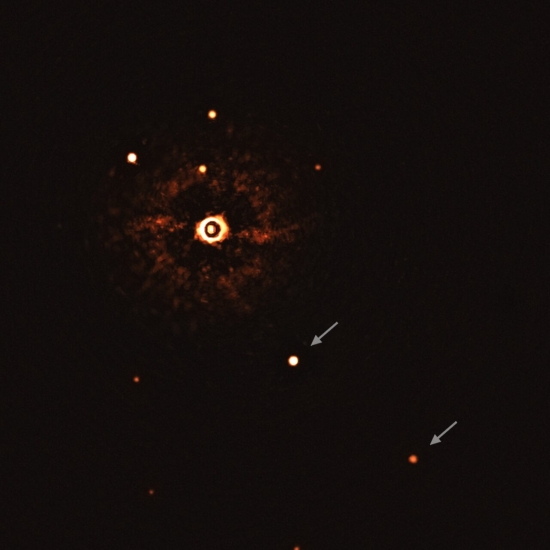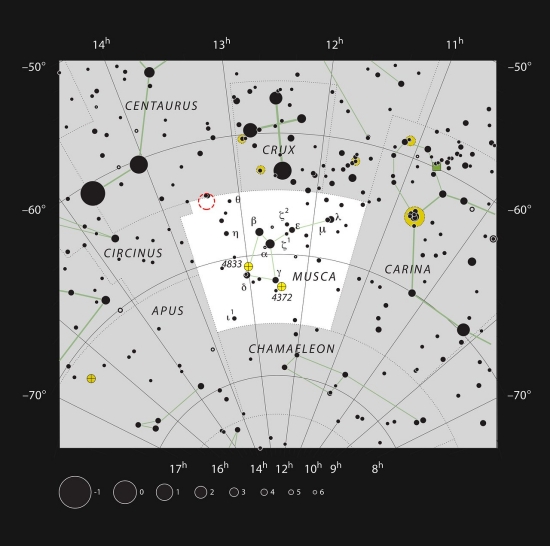At this point in the exoplanet hunt, actual images of our quarry are uncommon, but few more so than today’s image, made with the European Southern Observatory’s Very Large Telescope. This is being billed as the first image ever taken of a young Sun-like star accompanied by multiple planets, in this case two gas giants. And I do mean young: At 17 million years old, this star has spawned planets recently enough that their hot glow makes the image possible.

Image: First ever image of a multi-planet system around a Sun-like star. The arrows point to the planets; the other bright objects are background stars. Credit: European Southern Observatory.
Designated TYC 8998-760-1, the host star is some 300 light years away in the southern constellation of Musca (The Fly), with a mass close to that of the Sun, described in the paper on this work as a solar analogue. The two gas giants orbit the star at 160 and 320 AU, and both are more massive than our Jupiter and Saturn, with the inner planet at 14 times Jupiter’s mass and the outer at six times Jupiter’s mass. The youth of the system suggests what our Solar System may have been like early in its formation. Did these gas giants migrate to their current position, or did they form in place?
The answer would depend on the various values for the eccentricities of their orbits, which the authors can vary in their calculations to produce stable orbits on billion-year timescales if the eccentricity is low (near-circular orbits), and a chaotic system with likely future interactions between the planets if the eccentricity is high. It will take further observations to make the call. Young systems like these should prove useful for analyzing both scenarios around other stars, as the authors note, while also pointing to the opportunities for future observation from space:
TYC 8998-760-1 is a prime system to further study the dynamical and chemical properties of two coeval, gravitationally bound, gas giant planets. Continuous astrometric monitoring will constrain the orbital solutions for both companions and thus enable testing of potential formation scenarios. Due to the wide separations of both companions, contaminating flux from the primary is negligible, so spectral characterization at high resolution is easily accessible to determine rotational periods and molecular abundances in the planetary atmospheres… Multi-wavelength photometric variability monitoring with space-based observatories such as HST and JWST… will facilitate studies of the vertical cloud structures in these Jovian companions. Even mid-infrared spectroscopy with JWST/MIRI will be feasible to provide benchmark spectra for theoretical atmosphere models of young, sub-stellar companions at wavelengths longer than 5 microns.
We’ve seen the number of directly imaged worlds increasing because of imagers that use adaptive optics, like the Gemini Planet Imager (GPI) and the Spectro-Polarimetric High-contrast Exoplanet REsearch (SPHERE) instrument. The image above is from SPHERE, mounted on the VLT in Chile, which operates at highest contrast at optical and near-infrared wavelengths.

Image: Location of TYC 8998-760-1 in the constellation of Musca. Credit: ESO.
The other two exoplanet systems currently in our catalog with two or more directly imaged planets both involve stars considerably different from the Sun. One of them is found at HR 8799, a 30 million year old star in spectral class A5, with four giant planets orbiting between 15 and 70 AU from their host. The other, at PDS 70, is a K7-class star that is even younger, with an age estimated at 5.4 million years and two accreting protoplanets inside the circumstellar disk.
The paper is Bohn et al., “Two Directly Imaged, Wide-orbit Giant Planets around the Young, Solar Analog TYC 8998-760-1,” Astrophysical Journal Letters Volume 898, Number 1 (22 July 2020). Abstract.



Amazing work/accomplishment! I have a few questions:
1). Given the orbital separation from their primary star and the known inefficiency of core accretion at these distances, might a formation scenario involving so-called “gravitational collapse” be more likely than core accretion (assuming that these planets did not form closer in and then migrate out to their present locations)?
2). One of the planets is quite massive. Is it possible that the ~14 Mj “planet” is actually a small brown dwarf as opposed to a giant planet?
3). How might the core of a giant planet formed via core accretion differ in its physical/chemical properties from a giant planet formed by gravitational collapse?
a brown dwarf that young would be much hotter, I’d guess, probably still fusing deuterium.
An amazing image! At first look, one is drawn to the background stars at further distance, but then the discovery of a sun-like star with a planetary system built on such a scale! It might be too tenuous an observation at this point, noting that the inner two of the planets is the more massive, by definition it is within the realm of brown dwarfs. This is almost a test case for the discussions we had in an earlier article. Possibly the inner planet is already ignited for deuterium fusion? The color and brightness would suggest significantly more luminosity and temperature than the body further out. Heat of formation would be significant for both; equilibrium temperatures at hundreds of AUs from the primary would be less than 35 K, considering Pluto or Triton as illustrative hereabout. Reflecting on their distance from primary further, wonder what kind of astrometry campaign was involved?
Orbit at such distances at 100 parsecs away does not a milli-parsec make in any short interval of time. Some doppler in there?
Wobbles and dips are convincing in an intellectual sense, but there’s nothing like the visceral impact of an image of an exoplanet.
So, younger/hotter gas giants are easier quarry for current instruments whereas older/colder gas giants are not yet detectable via current telescopes. That said, are there any ground-based telescopes planned for first light in the 2020s that could image another star system’s version of Jupiter and Saturn at, say, 50-100 light years?
LUVOIR-A.
This is the telescope that is needed to explore and direct image planets to more the 40 light-years. The 15 meters telescope in space will tell us if life exist beyond earth and may find technosignatures on nearby planets! Time to push for this project, the technology is already in hand and the NASA/ESA teams are already available, we need to start a campaign for funding this telescope.
The LUVOIR Mission Concept Study Final Report.
https://arxiv.org/abs/1912.06219
426 Pages!
https://twitter.com/hashtag/LUVOIR?src=hashtag_click
This is a little off topic but a very good read and may relate to looking in the infrared to x-ray bands and Dysonian SETI for ET.
Habitability of M dwarfs is a problem for the traditional SETI.
“We consider some implications of the much-discussed circumstellar habitable zones around M-dwarf stars for the conventionally understood radio SETI. We argue that the flaring nature of these stars would further adversely impact local development of radio communication and that, therefore, their circumstellar habitable zones should be preferentially studied by other methods. This is a clear example how diversity of astrobiological habitats is introducing contingency into the cultural evolution, thus undermining the universality of cultural convergence as one of the major premises of the traditional SETI. This is yet another example of how specifics of the physical environment strongly shape cultural evolution taken in the broadest, most inclusive sense.”
https://arxiv.org/abs/2007.12645
My own thoughts on this subject is that we look at communications in the sense of how much data can be sent and received when long lived alien cultures may look at long low level communications over years for a message. Think giant whales singing their long deep songs thru the huge big oceans or tortuously long Vogon poetry!
On a similar subject, here’s an interesting preprint that showed up on the arXiv this week:
Lazzoni et al. “The search for disks or planetary objects around directly imaged companions: A candidate around DH Tau B”
DH Tau B has a projected separation of ~330 AU from its host star and has a mass estimate close to the deuterium-burning limit. The companion (if it exists) would be a ~Jupiter-mass object at ~10 AU.
It seems like over the years there have brown dwarf “planets” directly observed in orbit about visible main sequence stars.
For Beta Pictoris b, the data obtained in 2003 took another 5 years for determination of a lower boundary brown dwarf. That was also preceded by the 1997 image of GL-229 b. It sticks in my memory on account of a conference that year where it was discussed. But the six
Jupiter mass outside orbiter – if the mass assessment remains that’ s observation of a planet – perpendicular to the orbital plane.
Just like with paintings in a museum, looking at the tints of those two bodies suggests something like what you might experience looking at Jupiter with a backyard telescope – but yet it is not. Those disks simply can’t be resolved any tighter. After all, brown dwarfs and Jupiters are roughly the size of Jupiter and these objects are more than a hundred AUs from their prime. But saying that, and these objects are very young, could they be distended due to their significant internal heat?